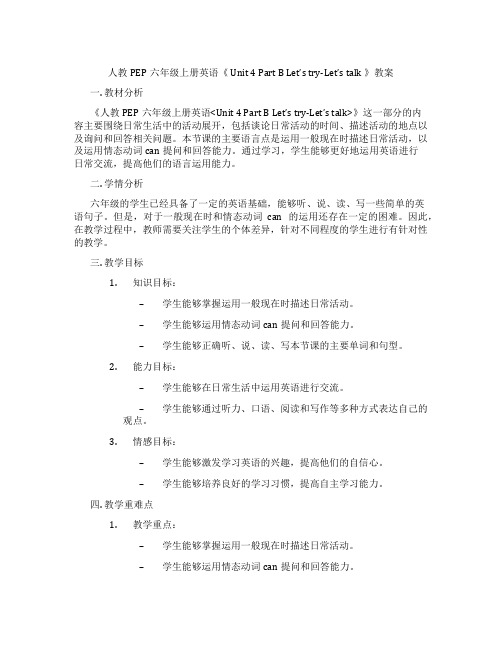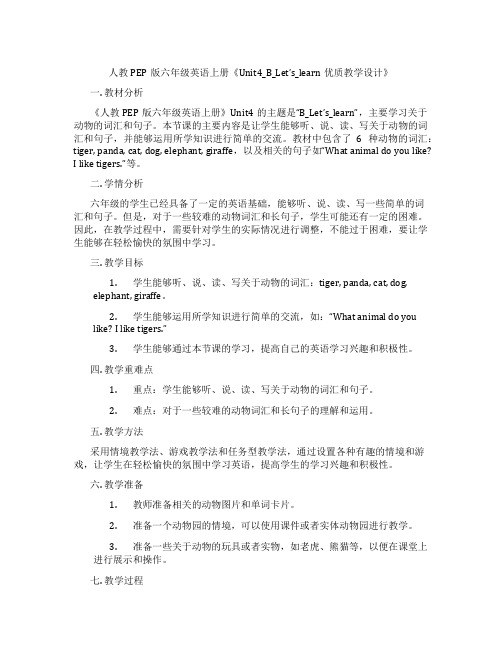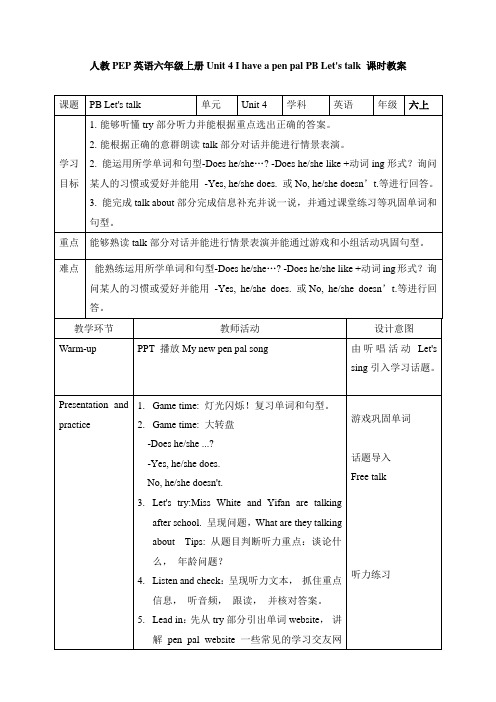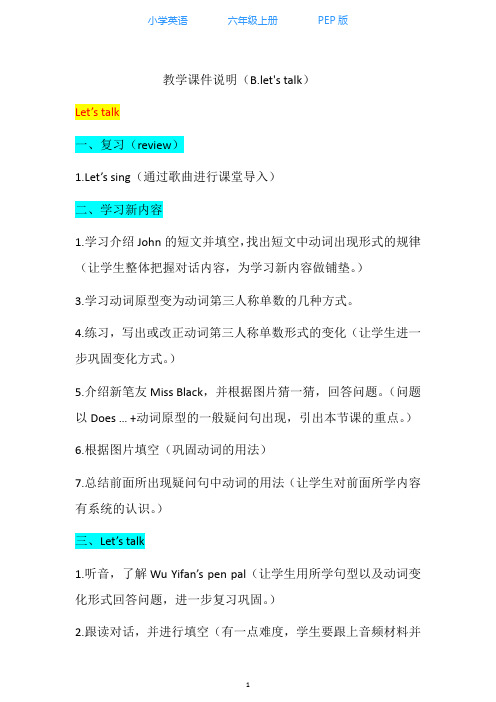PEP人教版六年级英语上册《Unit4_B_Let’s_talk教学设计》
人教PEP六年级上册英语《Unit4PartBLet'stry-Let'stalk》教学设计

人教PEP六年级上册英语《Unit 4 Part B Let’s try-Let’s talk 》教学设计一. 教材分析本课选自人教版PEP六年级上册英语Unit 4 Part B Let’s try-Let’s talk部分。
本部分主要讲述了一个关于动物及其叫声的故事。
通过本节课的学习,学生能够听懂、会说、会读关于动物的词汇:panda, tiger, penguin, dolphin等,以及表示动物叫声的词汇:meow, growls, quack, tweet等。
同时,学生还能够理解并在适当的情境中运用一般现在时描述动物的特点。
二. 学情分析六年级的学生已经掌握了基本的英语语法知识和一定数量的词汇,具备了初步的听力理解和口语表达能力。
对于本节课的内容,学生对于动物的兴趣较高,有利于激发他们的学习积极性。
但是,部分学生对于一般现在时的运用还不够熟练,需要老师在教学中进行针对性的指导。
三. 教学目标1.知识目标:–学生能够听懂、会说、会读关于动物的词汇:panda, tiger, penguin, dolphin等,以及表示动物叫声的词汇:meow, growls, quack,tweet等。
–学生能够在适当的情境中运用一般现在时描述动物的特点。
2.能力目标:–学生能够通过听、说、读、写等多种方式,提高自己的语言运用能力。
–学生能够在小组合作中,提高自己的团队协作能力。
3.情感目标:–学生能够培养对动物的关爱之情,增强保护动物的意识。
四. 教学重难点•学生能够听懂、会说、会读关于动物的词汇和表示动物叫声的词汇。
•学生能够在适当的情境中运用一般现在时描述动物的特点。
•学生对于一般现在时的运用,特别是在描述动物特点时的运用。
五. 教学方法本节课采用任务型教学法、情境教学法和交际法进行教学。
通过创设情境,引导学生参与各种语言实践活动,提高他们的语言运用能力。
同时,采用小组合作的方式,培养学生的团队协作能力。
人教PEP六年级上册英语《Unit4PartBLet'stry-Let'stalk》教案

人教PEP六年级上册英语《Unit 4 Part B Let’s try-Let’s talk 》教案一. 教材分析《人教PEP六年级上册英语<Unit 4 Part B Let’s try-Let’s talk>》这一部分的内容主要围绕日常生活中的活动展开,包括谈论日常活动的时间、描述活动的地点以及询问和回答相关问题。
本节课的主要语言点是运用一般现在时描述日常活动,以及运用情态动词can提问和回答能力。
通过学习,学生能够更好地运用英语进行日常交流,提高他们的语言运用能力。
二. 学情分析六年级的学生已经具备了一定的英语基础,能够听、说、读、写一些简单的英语句子。
但是,对于一般现在时和情态动词can的运用还存在一定的困难。
因此,在教学过程中,教师需要关注学生的个体差异,针对不同程度的学生进行有针对性的教学。
三. 教学目标1.知识目标:–学生能够掌握运用一般现在时描述日常活动。
–学生能够运用情态动词can提问和回答能力。
–学生能够正确听、说、读、写本节课的主要单词和句型。
2.能力目标:–学生能够在日常生活中运用英语进行交流。
–学生能够通过听力、口语、阅读和写作等多种方式表达自己的观点。
3.情感目标:–学生能够激发学习英语的兴趣,提高他们的自信心。
–学生能够培养良好的学习习惯,提高自主学习能力。
四. 教学重难点1.教学重点:–学生能够掌握运用一般现在时描述日常活动。
–学生能够运用情态动词can提问和回答能力。
2.教学难点:–学生能够正确运用一般现在时和情态动词can进行实际交流。
五. 教学方法1.情境教学法:通过设定真实的生活情境,让学生在实际语境中学习、运用英语。
2.任务型教学法:通过完成各种任务,激发学生的学习兴趣,提高他们的实践能力。
3.合作学习法:引导学生进行小组合作,培养他们的团队精神和沟通能力。
4.游戏教学法:通过设计有趣的游戏,让学生在轻松愉快的氛围中学习英语。
六. 教学准备1.教学材料:教材、多媒体课件、录音机、磁带、相关图片等。
PEP人教版六年级英语上册《Unit4_B_Let’s_talk教学设计》

Unit4 B Let’s talk 教学设计(B Let’s try Let’s talk)一、教学目标(一)认知目标能够听、说、读、写句子Does he live in Sydney? No, he doesn’t. Does he like doing word puzzles and going hiking? Yes, he does.并能在实际生活中运用。
(二)能力目标能够运用所学句型来询问他人一些日常生活情况。
(三)情感目标教育学生要养成良好的学习和生活习惯。
二、教学重难点(一)重点灵活运用本节课的重点句型。
朗读时做到语调自然,语音准确。
突破方法:反复朗读,小组互听朗读,提出建议,突破重点。
(二)难点在实际情景中正确运用所学对话。
突破方法:创设情景,表演对话,突破难点。
三、教法与学法引导法,点拨法,小组讨论法。
四、教学准备教师准备多媒体课件、课文情景动画或音频MP3()。
相应的教学图片,单词卡片等。
五、教学过程Step 1: Warm-up1. 播放歌曲My new pen pal,师生齐唱。
2. 师生进行日常会话。
如:T: Where are you from?S: I’m from China.T: What do you do on Sundays?S: I often read books.T: How do you go to school?S: I go to school by bike.T: Do you go to school by subway?S: No, I don’t.T: Do you have a pen pal?S: Yes, I do.Step 2 :PresentationLet’s try教师先引导学生看问题,然后播放Let’s try部分的录音,学生回答问题。
教师再次播放录音,让学生找出回答问题的关键信息,核对答案。
最后让学生反复听,尽量听出原文并进行复述。
人教PEP六年级上册英语《 Unit 4 Part B Let's try-Let's talk 》

人教PEP六年级上册英语《Unit 4 Part B Let’s try-Let’s talk 》说课稿一. 教材分析人教PEP六年级上册英语《Unit 4 Part B Let’s try-Let’s talk》的内容主要围绕“询问时间”这一主题展开。
通过本节课的学习,学生能够掌握询问现在时间、表达时间的相关词汇和句型,如“What time is it?” “It’s time for lunch.”等,并能够运用所学知识进行简单的交流。
教材内容贴近学生的生活,有利于激发学生的学习兴趣,提高学生的语言运用能力。
二. 学情分析六年级的学生已经掌握了基本的英语语法和词汇,具备一定的听说读写能力。
他们在日常生活中也经常会接触到时间相关的场景,对于询问和表达时间有一定的认识和理解。
但部分学生可能在发音和听力方面还存在困难,需要教师在教学过程中给予重点关注和指导。
三. 说教学目标1.知识目标:学生能够掌握询问时间、表达时间的词汇和句型,如“What time is it?” “It’s time for lunch.”等,并能够熟练运用所学知识进行交流。
2.能力目标:学生能够在日常生活中运用英语询问和表达时间,提高他们的语言运用能力。
3.情感目标:通过本节课的学习,学生能够培养对英语学习的兴趣,增强自信心,提高合作意识和团队精神。
四. 说教学重难点1.重点:学生能够掌握询问时间、表达时间的词汇和句型,并能够熟练运用所学知识进行交流。
2.难点:学生能够正确理解并运用“What time is it?” “It’s time for lunch.”等句型进行实际场景的交流。
五. 说教学方法与手段本节课采用任务型教学法,通过设定各种真实场景,引导学生运用所学知识进行实际交流。
同时,运用多媒体教学手段,如课件、视频等,丰富教学内容,激发学生的学习兴趣。
六. 说教学过程1.热身活动(5分钟):教师与学生进行简单的英语对话,询问学生的一些基本信息,如姓名、年龄等,引导学生进入英语学习氛围。
pep人教版小学六年级上册小学英语《Unit 4 I have a pen pal B Let’s talk》教学设计

pep人教版小学六年级上册小学英语Unit 4 I have a pen pal BLet’s talk教材:《小学英语(pep人教版)》六年级上册P40课型:对话教学时间:40分钟一、教学内容分析本节课选自由人民教育出版社课程研究所、英语课程教材研究开发中心、加拿大灵通教育有限公司联合编写,人民教育出版社出版的《小学英语(pep 人教版)》六年级上册第四单元I have a pen pal B部分的let’s talk. 对话的大意是:吴一凡在给笔友写邮件,约翰向吴一凡询问了一些关于他笔友的信息,然后发现吴一凡的笔友也叫约翰,而且和约翰有这同样的爱好,因此约翰也想和吴一凡的笔友成为笔友。
对话的内容如下:John: Hey, Yifan. What are you doing?Wu Yifan: I’m writing an email to my new pen pal in Australia.John: Does he live in Sydney?Wu Yifan: No, he doesn’t. He lives in Canberra. His name is John, too.John: Really? Does he like doing word puzzles and going hiking?Wu Yifan: Yes, he does.John: Amazing! I like those too! Can I also be his pen pal?Wu Yifan: Sure. Why not?John: Cool!学生已经学过如果询问关于人物姓名、爱好、家庭成员、经常做的事情等,但是对话当中出现的Does开头的一般疑问句还没学过,因此本节课,帮助学生复习人物的相关问题,并学会使用Does来询问关于笔友的信息是本课的重点难点。
二、学情分析六年级的学生已经学习英语几年了,具备基本的对话能力,询问人物信息的能力,而且六年级的学生活泼好动,爱表现。
人教PEP版小学英语六年级上册Unit 4B.Let's talk说课稿

六年级上册Unit 4 Part B Let talk说课稿今天我说课的题目是《Unit 4 I Have A Pen Pal》的B部分Let talk 首先我来进行教材分析。
教材分析:1、本节课出自人民教育出版社出版的小学《英语》六年级上册第四单元第五课时2、本节课联系了四年级和五年级的教学内容,在以后复习阶段具有重要意义。
3、本节课是在学习一般疑问句的基础上,进一步学习含有第三人称单数作主语的一般疑问句.。
教学目标知识目标:1、能够听、说、读、写句型Does she teach English? No, she doesn’t. Yes, she does.2、能够用上面句式询问他人一些日常生活情况。
能力目标;1、分组学习方式,培养学生与他人沟通交流的能力。
2、通过设置问题情境,提高学生分析和解决问题的能力。
情感目标:1、培养学生认真、细致的学习态度。
2、通过发现问题、解决问题的过程,培养学生合作精神,增强学生的求知欲和对学习的热情。
重点难点重点:能够熟练掌握本课时的重点句型,并在现实生活中灵活运用,做到语调自然,语音准确。
难点:在实际情景中运用所学的对话。
教法:1、教师精讲、学生多练,体现了以学生为主体、教师为主导的教学原则。
2、采用类比法,引导学生发现问题,自主学习,从而体验到独立获取知识的喜悦感。
3、通过“教”“学”“放”“收”突破重点和难点。
学法:1、主动学习法:举出例子,提出问题,让学生在获得感性认识的同时,教师层层深入,启发学生积极思维,主动探索知识,培养学生思维想象的综合能力。
2、反馈补救法:在练习中,注意观察学生对学习的反馈情况,以实现“培优扶差,满足不同。
”教学过程:我将本节课分为三个部分。
用约5分钟时间进行导入部分,主要是复习和引入新课。
用约25分钟时间进行正体部分。
主要是通过讲练结合的方式完成B 部分Let talk部分的学习。
最后,用约5分钟的时间进行尾声部分,主要是小结和作业。
人教PEP版六年级英语上册《Unit4_B_Let’s_talk浙江公开课教案》

人教PEP版六年级英语上册《Unit4_B_Let’s_talk浙江公开课教案》一. 教材分析《人教PEP版六年级英语上册》的Unit4主要围绕“节日”这个主题展开。
本单元的B部分“Let’s talk”主要讲述了一个关于节日的故事,通过故事让学生掌握日常英语表达,提高他们的听说能力。
教材内容丰富,插图生动,易于学生理解。
二. 学情分析六年级的学生已经具备了一定的英语基础,对于日常的英语交流已经有了一定的掌握。
但是,他们在口语表达和听力理解方面还存在一定的困难。
因此,在教学过程中,需要关注学生的个体差异,针对不同程度的学生进行有针对性的教学。
三. 教学目标1.知识目标:让学生掌握关于节日的日常英语表达,提高他们的听说能力。
2.能力目标:培养学生的口语表达能力,提高他们的听力理解能力。
3.情感目标:让学生了解不同国家的节日文化,培养他们的跨文化交际意识。
四. 教学重难点1.重点:让学生掌握关于节日的日常英语表达。
2.难点:提高学生的听力理解能力和口语表达能力。
五. 教学方法1.任务型教学法:通过完成任务,让学生在实践中掌握知识。
2.情境教学法:创设真实的情境,让学生在交流中提高英语能力。
3.游戏教学法:通过趣味游戏,激发学生的学习兴趣。
六. 教学准备1.教学材料:教材、多媒体课件、录音机、磁带。
2.教学环境:教室、多媒体设备。
七. 教学过程1.导入(5分钟)等。
然后引入本课的主题——关于节日的对话。
2.呈现(10分钟)教师播放教材中的录音,让学生听懂对话内容。
然后通过图片展示,让学生跟读对话,注意发音和语调。
3.操练(10分钟)教师学生进行角色扮演,让学生模拟对话中的情景,进行实际操作。
学生在练习过程中,教师应及时给予指导和反馈。
4.巩固(10分钟)教师设计一些关于节日的问答游戏,让学生在游戏中进一步巩固所学知识。
同时,鼓励学生大胆开口,提高他们的口语表达能力。
5.拓展(10分钟)教师引导学生谈论不同国家的节日,让学生了解世界各地的节日文化。
人教PEP版六年级英语上册《Unit4_B_Let’s_learn优质教学设计》

人教PEP版六年级英语上册《Unit4_B_Let’s_learn优质教学设计》一. 教材分析《人教PEP版六年级英语上册》Unit4的主题是“B_Let’s_learn”,主要学习关于动物的词汇和句子。
本节课的主要内容是让学生能够听、说、读、写关于动物的词汇和句子,并能够运用所学知识进行简单的交流。
教材中包含了6种动物的词汇:tiger, panda, cat, dog, elephant, giraffe,以及相关的句子如“What animal do you like?I like tigers.”等。
二. 学情分析六年级的学生已经具备了一定的英语基础,能够听、说、读、写一些简单的词汇和句子。
但是,对于一些较难的动物词汇和长句子,学生可能还有一定的困难。
因此,在教学过程中,需要针对学生的实际情况进行调整,不能过于困难,要让学生能够在轻松愉快的氛围中学习。
三. 教学目标1.学生能够听、说、读、写关于动物的词汇:tiger, panda, cat, dog,elephant, giraffe。
2.学生能够运用所学知识进行简单的交流,如:“What animal do youlike? I like tigers.”3.学生能够通过本节课的学习,提高自己的英语学习兴趣和积极性。
四. 教学重难点1.重点:学生能够听、说、读、写关于动物的词汇和句子。
2.难点:对于一些较难的动物词汇和长句子的理解和运用。
五. 教学方法采用情境教学法、游戏教学法和任务型教学法,通过设置各种有趣的情境和游戏,让学生在轻松愉快的氛围中学习英语,提高学生的学习兴趣和积极性。
六. 教学准备1.教师准备相关的动物图片和单词卡片。
2.准备一个动物园的情境,可以使用课件或者实体动物园进行教学。
3.准备一些关于动物的玩具或者实物,如老虎、熊猫等,以便在课堂上进行展示和操作。
七. 教学过程1.导入(5分钟)教师通过播放一首关于动物的歌曲,引导学生进入动物园的情境。
小学人教PEP版英语六年级上册Unit4-B-Let’s-talk名师教案

教材版本:小学英语六年级上册第四单元2. Free talk:T: Do you have a pen pal What are his/her hobbies Where are they come fromIf you have a pen pal, what do you want to know about him or herNameCity 请一名学生介绍他笔友的有关情况,如:I have a pen pal. She lives in Beijing ・ I live in Wuhan. Shelikes climbing mountains, singing and swimming, but I like drawing cartoons and dancing ・ We often write emails ・ 根据这名学生的介绍问其他学生:Does his pen pal live in Bei jing/Wuhan … 引导学生回答:Yes, he/she does. /No, she doesn' t ・ She lives in … T: Wu Yifan has a new pen pal. Let' s see what he is like ・ Step 2: Presentation1. Let' s try引导学生看问题,What are Miss White and Wu Yifan talking about How old is the student播放Let' s try 部分的录音,学生找出关键信息。
再次播放录音,核对答案。
最后让学生尽量听出原文并进行复述。
Let' s talk 2. 播放Let' s talk 部分的录音,听两遍录音后回答问题。
① What is Wu Yifan doing② Where does Wu Yifan* s pen pal live③ What do the two Johns like引导学生回答问题,并答疑。
人教PEP英语六年级上册教案U4-B

Unit 4 I have a pen palPart BLet's try & Let's talk【教学目标】1.能够听、说、读、写句子“Does he live in Sydney? No, he doesn’t. Does he like word puzzles and going hiking? Yes, he does.”并能在实际情景中正确运用。
2.能正确听、说、认、读单词“amazing, Canberra”。
3.运用一般现在时的一般疑问句句型:Does he/she…?来进行提问。
【教学重难点】重点:能够运用一般现在时的一般疑问句型“Does he/she…?”来进行提问,并能作答。
难点:学生能够在真实的语境中灵活运用本课重点句型,并能根据课文大胆创编对话。
【课前准备】课件、教学光盘、人物头饰【教学过程】Step 1:Warm-up1.播放歌曲“My new pen pal”,在欢快的旋律下进入本课的学习。
2.同桌二人谈论自己的笔友的爱好。
Step 2: Presentation1.完成“Let’s try”部分的任务。
先介绍背景引导学生观察问题,然后播放听力,找出问题答案。
再次播放,核对答案。
2.教师播放一段视频,展示自己笔友自我介绍的视频:Hello, I’m Caroline, Miss Chen’s pen pal. I live in Shang hai. I like singing and swimming. We often send emails to each other.(1)根据所播放的视频,教师提问:Does she live in Beijing? 引导学生作回答:No, she doesn’t.T: Does she live in Guangzhou? S: No, she doesn’t.(2)要求学生提问:Does she like dancing/singing/reading stories/doing kung fu? 教师可以一一做答,肯定:Yes, she does.否定:No, she doesn’t.(3)老师引导谈自己的“pen pal”的兴趣,并展示两张图片:doing word puzzles, going hiking,带入句型练习:Does she like doing word puzzles/going hiking?3.板书重点句子,并要求二人一组替换问答:Does he live in Sydney? No, he doesn’t.Does he like doing word puzzles and going hiking? Yes, he does.4.播放“Let’s talk”录音,边听边画出不理解的句子、单词,并思考问题:(1)What do the two Johns like?(2)What is Wu Yifan doing?(3)Where does Wu Yifan’s pen pal live?核对答案,并讲解需认读的单词如(Canberra, amazing);再放一遍,学生跟读,然后同桌二人分角色练习,表演对话。
人教版六年级英语上册Unit 4第四单元 B Let's talk说课稿

六年级上册Unit 4 Part B Let talk说课稿今天我说课的题目是《Unit 4 I Have A Pen Pal》的B部分Let talk 首先我来进行教材分析。
教材分析:1、本节课出自人民教育出版社出版的小学《英语》六年级上册第四单元第五课时2、本节课联系了四年级和五年级的教学内容,在以后复习阶段具有重要意义。
3、本节课是在学习一般疑问句的基础上,进一步学习含有第三人称单数作主语的一般疑问句.。
教学目标知识目标:1、能够听、说、读、写句型Does she teach English? No, she doesn’t. Yes, she does.2、能够用上面句式询问他人一些日常生活情况。
能力目标;1、分组学习方式,培养学生与他人沟通交流的能力。
2、通过设置问题情境,提高学生分析和解决问题的能力。
情感目标:1、培养学生认真、细致的学习态度。
2、通过发现问题、解决问题的过程,培养学生合作精神,增强学生的求知欲和对学习的热情。
重点难点重点:能够熟练掌握本课时的重点句型,并在现实生活中灵活运用,做到语调自然,语音准确。
难点:在实际情景中运用所学的对话。
教法:1、教师精讲、学生多练,体现了以学生为主体、教师为主导的教学原则。
2、采用类比法,引导学生发现问题,自主学习,从而体验到独立获取知识的喜悦感。
3、通过“教”“学”“放”“收”突破重点和难点。
学法:1、主动学习法:举出例子,提出问题,让学生在获得感性认识的同时,教师层层深入,启发学生积极思维,主动探索知识,培养学生思维想象的综合能力。
2、反馈补救法:在练习中,注意观察学生对学习的反馈情况,以实现“培优扶差,满足不同。
”教学过程:我将本节课分为三个部分。
用约5分钟时间进行导入部分,主要是复习和引入新课。
用约25分钟时间进行正体部分。
主要是通过讲练结合的方式完成B 部分Let talk部分的学习。
最后,用约5分钟的时间进行尾声部分,主要是小结和作业。
人教PEP版六年级英语上册《Unit4_B_Let’s_learn名师教学设计》

人教PEP版六年级英语上册《Unit4_B_Let’s_learn名师教学设计》一. 教材分析本课为人教PEP版六年级英语上册《Unit4_B_Let’s_learn》,主要讲述了动物的特点。
通过本课的学习,学生能够听、说、读、写关于动物的词汇,如panda, tiger, parrot, penguin等,并能够运用所学词汇描述动物的特点。
教材内容丰富,插图可爱,激发学生的学习兴趣。
二. 学情分析六年级的学生已经具备了一定的英语基础,能够听、说、读、写一些简单的英语句子。
但是,对于一些动物的特点,学生可能还不太了解。
因此,在教学过程中,教师需要结合教材内容,引导学生学习动物的特点,并能够运用所学词汇进行描述。
三. 教学目标1.知识目标:学生能够听、说、读、写关于动物的词汇,如panda,tiger, parrot, penguin等,并能够运用所学词汇描述动物的特点。
2.能力目标:学生能够通过图片和词汇,正确描述动物的特点,提高学生的英语表达能力。
3.情感目标:培养学生热爱动物,关注生态环境的意识。
四. 教学重难点1.重点:学生能够听、说、读、写关于动物的词汇,如panda, tiger,parrot, penguin等。
2.难点:学生能够运用所学词汇描述动物的特点。
五. 教学方法1.情境教学法:通过创设情境,让学生在真实的环境中学习动物的特点,提高学生的学习兴趣。
2.任务型教学法:通过完成任务,引导学生运用所学词汇描述动物的特点,提高学生的实践能力。
3.游戏教学法:通过趣味游戏,激发学生的学习兴趣,巩固所学知识。
六. 教学准备1.教材、课件和教学资源。
2.图片、卡片等教具。
3.录音机、音响等设备。
七. 教学过程1.导入(5分钟)教师通过播放动物的歌曲,引导学生进入学习状态。
然后,向学生提问:“你们喜欢动物吗?为什么?”让学生发表自己的观点,激发学生的学习兴趣。
2.呈现(10分钟)教师展示教材中的图片,引导学生说出图片中的动物。
新版pep小学六年级英语第四单元Blet's talk 教案

所用教科书书名2014新版PEP英语六年级上册(三年级起点)所教年级六年级所教册次、单元上册第四单元设计主题Unit4 I have a pen pal一.整体设计思路、指导依据说明本教案的编写以我国《教育振兴行动计划》和《基础教育课程改革纲要(试行)》的精神为指导,以任务型教学法为整体设计思路,以《英语新课程标准》为依据,为学生设置情景,使学生身临其境的去学习本次课的内容,以达到显著的教学效果。
二.教学背景分析教学内容分析:本部分的教学内容为六年级上册第四单元Part B Let’s try和Let’s talk 。
Let’s try通过Miss White 和吴一凡的聊天呈现了新句型。
学生通过听力练习获得了Let’s talk的人物及场景信息,为进入正式的对话学习做好准备。
Let’s talk学习的核心句型是:Does he live in Sydney? No,he doesn’t. Does he like doing word puzzles and going hiking? Yes,he does.教材通过John 和吴一凡聊笔友的情景,让学生感知上述句型的语义及语用情景。
学生情况分析:通过Part A的学习,学生已经掌握了句型:What are …’s hobbies? He/ She likes…并能运用以上句型谈论他人的爱好。
三.教学目标分析通过本课时的学习,学生能够:1.听、说、读、写词组和句型:does word puzzles,g oes hiking;Does he live in Sydney? No,he doesn’t. Does he like doing word puzzles and going hiking? Yes,he does.2.在情景中正确使用上述词组和句型谈论或描述他人和自己的兴趣爱好和日常活动。
3.读懂Let’s try听力题目的要求,巩固听前根据题目预测重点内容的听力技巧。
小学英语六年级上册Unit 4 Part B Let's talk教学设计

14.Show time:配音擂台,播放动画,学生给动画进行配音。
15.Practice:根据课文判断正误
16.Listen and fill:听音频,补全句子,熟悉句型,
No, he/she doesn't.
3.Let's try:Miss White and Yifan are talking after school.呈现问题,What are they talking about Tips:从题目判断听力重点:谈论什么,年龄问题?
4.Listen and check:呈现听力文本,抓住重点信息,听音频,跟读,并核对答案。
5.Lead in:先从try部分引出单词website,讲解pen pal website一些常见的学习交友网站,例如:Penpalworld Livemocha Facebook在某个网站上用介词on
6.Lead in:呈现场景图Yifan is writing an email to his new pen pal. Where does his new pen pal live? What does he like? Let's watch!提出问题:带着问题看动画!
7.Presentation:播放talk部分动画!理解大意.并注意语音语调,
8.Read quickly and try to find out:老师提出几个问题,学生自由阅读并尝试找出答案,
9.Presentation:和老师一起寻找答案吧!可以邀请个别学生说出自己的答案和理由。检阅学生自主阅读的能力和方法。
人教PEP版六年级英语上册《Unit4_B_Let’s_learn优质教案》

人教PEP版六年级英语上册《Unit4_B_Let’s_learn优质教案》一. 教材分析本课为人教PEP版六年级英语上册《Unit4_B_Let’s_learn》优质教案。
本节课主要通过学习有关动物的词汇和句子,让学生能够运用所学知识进行简单的交流。
教材内容丰富,插图可爱,激发学生的学习兴趣。
二. 学情分析六年级的学生已经具备一定的英语基础,对于图片和实物比较感兴趣,具备一定的合作意识和学习能力。
但部分学生英语口语表达能力仍需提高,因此在教学过程中需要注意激发学生的开口欲望,给予充分的时间进行操练。
三. 教学目标1.知识目标:学生能够听懂、会说、会读本节课的生词和句子。
2.能力目标:学生能够运用所学知识进行简单的动物主题交流。
3.情感目标:培养学生热爱动物,保护环境的意识。
四. 教学重难点1.重点:学生能够准确地听懂、说出生词和句子。
2.难点:学生能够运用所学知识进行实际交流。
五. 教学方法采用情境教学法、游戏教学法和任务型教学法,激发学生的学习兴趣,提高学生的参与度和积极性。
六. 教学准备1.准备相关动物的图片和实物。
2.准备课件和教学材料。
3.准备录音机和磁带。
七. 教学过程1.导入(5分钟)利用图片和实物,引导学生谈论他们喜欢的动物。
教师提问:“What’s your favorite animal? Why?”,让学生自由回答,从而引出本节课的主题。
2.呈现(10分钟)教师展示本节课的生词和句子,并用课件和实物进行辅助教学。
例如,展示一张狗的图片,并说:“This is a dog. It’s cute.”,让学生跟读。
3.操练(10分钟)学生分组,进行角色扮演,运用所学知识进行动物主题的交流。
例如,学生甲问:“What’s this?”, 学生乙回答:“It’s a cat.”,然后学生甲说:“It’s cute.”。
4.巩固(5分钟)教师设计游戏,让学生在游戏中复习本节课所学内容。
人教PEP版小学英语六年级上册教学设计(Unit4 B.Let's talk)docx

教学课件说明(B.let's talk)Let’s talk一、复习(review)1.Let’s sing(通过歌曲进行课堂导入)二、学习新内容1.学习介绍John的短文并填空,找出短文中动词出现形式的规律(让学生整体把握对话内容,为学习新内容做铺垫。
)3.学习动词原型变为动词第三人称单数的几种方式。
4.练习,写出或改正动词第三人称单数形式的变化(让学生进一步巩固变化方式。
)5.介绍新笔友Miss Black,并根据图片猜一猜,回答问题。
(问题以Does … +动词原型的一般疑问句出现,引出本节课的重点。
)6.根据图片填空(巩固动词的用法)7.总结前面所出现疑问句中动词的用法(让学生对前面所学内容有系统的认识。
)三、Let’s talk1.听音,了解Wu Yifan’s pen pal(让学生用所学句型以及动词变化形式回答问题,进一步复习巩固。
)2.跟读对话,并进行填空(有一点难度,学生要跟上音频材料并进行对话填空。
)四、归纳总结通过例题强调本课重点,助动词后加动词原型以及动词的第三人称单数形式。
五、Homework课外作业的布置。
让学生回归课本,通过作业的形式,巩固本次课所学内容,并为下次课的学习做准备。
PEP小学英语六年级上册重点单词和句型练习一、重点单词Unit 1:by ( ) foot( ) bike( ) bus( ) train( ) how( ) go to school() traffic()traffic light()traffic rule()stop()wait() get to()Unit 2library( ) post office( ) hospital( ) cinema( ) turn( ) bookstore( ) where( ) please( )next to( ) right ( ) left( ) straight( )then ( )Unit 3next week( ) this morning( ) this afternoon( ) this evening ( ) comic book( ) post card( ) newspaper( ) buy( )Unit 4hobby( ) ride a bike--riding a bike( )dive--diving( )play the violin—playing the violin( ) make kites—making kites( ) collect stamps—collecting stamps( ) live –lives( ) teach--teaches( ) go--goes( ) watch--watches( ) read--reads( ) does doesn’t=does notUnit 5singer( ) writer( ) actor( ) actress( ) artist( ) TV reporter( ) engineer( ) accountant( ) policeman( ) salesperson( ) cleaner( ) where() work()Unit 6rain( ) cloud ( ) sun( ) stream( ) come from( ) seed( ) soil( ) sprout ( ) plant( )should ( ) then( )Unit 1: ▁▁(经,乘) ▁▁(脚) ▁▁(自行车) ▁▁(公共汽车) ▁▁(火车)▁▁(怎样) ▁▁▁▁(上学)▁▁▁▁(交通)▁▁▁▁▁▁(交通灯)▁▁▁▁▁▁(交通规则)▁▁(停,停车站)▁▁(等待)▁▁▁▁(到达)Unit 2 ▁▁▁▁(图书馆) ▁▁▁▁(邮局) ▁▁▁▁(医院) ▁▁▁▁(电影院)▁▁(转弯) ▁▁▁▁(书店) ▁▁▁(在哪里,到哪里) ▁▁▁(请)▁▁▁(与…相邻) ▁▁▁ (右边) ▁▁(左边) ▁▁▁(成直线地) ▁▁▁(然后)Unit 3 ▁▁▁▁▁(下周) ▁▁▁▁▁(今天上午) ▁▁▁▁▁(今天下午)▁▁▁▁ (今天晚上) ▁▁▁▁(漫画书) ▁▁▁▁(明信片) ▁▁▁▁ (报纸) ▁▁▁(购买)Unit 4▁▁▁(爱好) ▁▁▁▁▁--▁▁▁▁▁▁(骑自行车) ▁▁▁--▁▁▁(跳水) ▁▁▁▁▁▁—▁▁▁▁▁▁▁(拉小提琴) ▁▁▁▁▁—▁▁▁▁▁▁▁(制作风筝) ▁▁▁▁▁▁—▁▁▁▁▁▁(集邮) ▁▁▁–▁▁▁(居住)▁▁▁▁--▁▁▁▁(教) ▁▁--▁▁▁(去) ▁▁▁--▁▁▁(看)▁▁--▁▁▁(读,看) does doesn’t=▁▁▁▁Unit 5▁▁▁▁(歌唱家,歌手) ▁▁▁▁(作家) ▁▁▁▁(男演员) ▁▁▁▁(女演员) ▁▁▁▁(画家) ▁▁▁▁(电视台记者) ▁▁▁▁(工程师) ▁▁▁(会计) ▁▁▁▁(男警察) ▁▁▁▁▁▁(销售员) ▁▁▁(工作)▁▁▁▁(清洁工) ▁▁▁▁(在哪里,到哪里)Unit 6▁▁▁(雨) ▁▁▁ (云) ▁▁▁(太阳) ▁▁▁▁(河,溪) ▁▁▁▁(来自,从…来) ▁▁▁(种子) ▁▁▁(土壤) ▁▁▁ (苗,芽) ▁▁▁(植物,种植) ▁▁▁(应该) ▁▁▁▁(然后)二、单词分类1)交通方式:by bus, by train, by subway, by ship, by plane, by car, on foot2)文具书籍:dictionary, newspaper, comic book, post card3)职业:singer, writer, TV reporter, actor, actress, engineer, accountant, salesperson, policeman, policewoman,artist, cleaner4)V-ing形式:riding a bike, collecting stamps, diving, making kites, playing the violin5)第三人称单数形式:lives,teaches, watches, goes, does, doesn’t6)公共场所:library,post office, cinema, hospital, science museum, bookstore7)方位:east, west, south, north, turn left, turn right, go straight8)交通灯; red light, yellow light, green light9)自然:sun, cloud, rain, vapour, stream六年级上册四会句子1.你是怎样去上学的?▁▁▁▁▁▁▁▁2.通常我走路去上学。
六年级上册英语说课稿《Unit4Ihaveapenpal-4BLet'stalk》人教(PEP)

六年级上册英语说课稿《Unit4 I have a pen pal-4 B Let’s talk》人教(PEP)一. 教材分析《Unit4 I have a pen pal-4 B Let’s talk》是人教版PEP小学英语六年级上册的一篇对话课文。
本节课的主要内容是学习关于介绍笔友的信息,并通过对话交流来提高学生的英语口语表达能力。
本节课的主要语言点是介绍自己的笔友,以及询问和回答关于笔友的个人信息。
教材通过两个简单的对话,让学生学会如何用英语介绍自己的笔友,并能够询问和回答关于笔友的问题。
二. 学情分析六年级的学生已经具备了一定的英语基础,能够听懂并能够运用简单的英语进行日常交流。
但是,学生在口语表达方面还存在一定的问题,需要通过大量的练习来提高。
此外,学生对于介绍自己的笔友这一主题可能比较陌生,需要通过教师的引导来进行学习和交流。
三. 说教学目标1.知识目标:学生能够听懂、说出一系列与笔友相关的词汇,如:penpal, letter, hobby等。
学生能够正确使用一般现在时态介绍自己的笔友,并能够询问和回答关于笔友的问题。
2.能力目标:学生能够通过听力理解,获取对话中的关键信息,并能够运用所学的语言知识进行口语表达。
3.情感目标:通过学习,学生能够体会到与笔友交流的乐趣,提高学习英语的兴趣。
四. 说教学重难点1.重点:学生能够听懂、说出一系列与笔友相关的词汇,并能够正确使用一般现在时态介绍自己的笔友,询问和回答关于笔友的问题。
2.难点:学生能够运用所学的语言知识进行口语表达,尤其是在询问和回答关于笔友的问题时,能够灵活运用所学知识。
五. 说教学方法与手段本节课采用情境教学法、交际法和生活化教学法进行教学。
在教学过程中,教师会创设一个关于笔友的情境,让学生在真实的语境中进行听力理解和口语表达。
同时,教师会通过提问、引导等方式,激发学生的思考和参与,提高学生的口语表达能力。
六. 说教学过程1.热身(5分钟):教师通过与学生进行简单的英语交流,引导学生进入英语学习的状态。
人教PEP版六年级英语上册《Unit4_B_Let’s_talk浙江公开课教学设计》

人教PEP版六年级英语上册《Unit4_B_Let’s_talk浙江公开课教学设计》一. 教材分析《人教PEP版六年级英语上册》Unit4的主题是关于动物,本节课为Unit4的第二部分B,Let’s talk部分。
通过本节课的学习,学生能够掌握并运用有关动物的词汇,如panda, tiger, parrot等,同时能够运用本节课所学的句型“What’s this? It’s a …”和“What’s that? It’s a …”进行简单的动物介绍。
二. 学情分析六年级的学生已经具备了一定的英语基础,能够听懂并运用一些简单的英语句型进行交流。
但是,对于一些动物的名称和特征可能还不够熟悉,因此需要通过图片和实物等辅助教学手段来进行引导和学习。
三. 教学目标1.知识目标:学生能够掌握并运用有关动物的词汇,如panda, tiger,parrot等,以及本节课所学的句型进行简单的动物介绍。
2.能力目标:学生能够在图片或实物的帮助下,正确地使用所学的词汇和句型进行交流。
3.情感目标:通过本节课的学习,学生能够增强对动物的认知和保护意识。
四. 教学重难点1.重点:学生能够掌握并运用有关动物的词汇和句型进行简单的动物介绍。
2.难点:学生能够正确地使用所学的词汇和句型在实际情景中进行交流。
五. 教学方法1.情境教学法:通过图片和实物等辅助教学手段,创设相关的教学情境,引导学生学习和运用所学的词汇和句型。
2.任务型教学法:通过小组合作等形式,让学生在实际任务中运用所学的词汇和句型,提高学生的实际运用能力。
六. 教学准备1.教学课件:制作相关的教学课件,包括动物的图片和实物的视频等。
2.教学卡片:制作有关动物的词汇卡片和句型卡片。
3.实物准备:准备一些动物的实物或模型,如熊猫、老虎等。
七. 教学过程1.导入(5分钟)通过播放一首关于动物的英文歌曲,激发学生的学习兴趣,引导学生进入本节课的学习主题。
2.呈现(10分钟)利用课件呈现本节课所要学习的动物词汇和句型,同时展示一些动物的实物或模型,让学生进行观察和认读。
人教版六年级上册英语《Unit4PartBLet'stry-Let'stalk(2)》说课稿

人教版六年级上册英语《Unit 4 Part B Let’s try-Let’s talk (2)》说课稿一. 教材分析人教版六年级上册英语《Unit 4 Part B Let’s try-Let’s talk (2)》是一篇关于日常生活中的活动安排和地点的对话。
本节课的主要内容是让学生能够听懂、会说并会用一般现在时描述日常活动和地点。
通过本节课的学习,学生能够进一步巩固一般现在时的用法,提高日常英语交流能力。
二. 学情分析六年级的学生已经掌握了基本的英语语法知识,对于一般现在时有一定的了解。
但是,学生在实际运用中还存在一定的困难,特别是在描述日常活动和地点方面。
因此,在教学过程中,教师需要注重学生的实际操作和实践,提高学生的英语应用能力。
三. 说教学目标1.知识目标:学生能够听懂、会说并会用一般现在时描述日常活动和地点。
2.能力目标:学生能够通过pr work和group work等形式,进行日常英语交流,提高口语表达能力。
3.情感目标:激发学生学习英语的兴趣,培养积极的学习态度。
四. 说教学重难点1.教学重点:学生能够听懂、会说并会用一般现在时描述日常活动和地点。
2.教学难点:学生能够在实际情景中灵活运用一般现在时进行日常交流。
五. 说教学方法与手段1.教学方法:采用交际法、任务型教学法、情境教学法等,引导学生主动参与,提高学生的实际操作和实践能力。
2.教学手段:利用多媒体课件、图片、卡片等辅助教学,创设真实、生动的学习情境。
六. 说教学过程1.Pre-class preparation:教师准备相关的多媒体课件、图片、卡片等教学材料。
2.Lead-in:通过与学生互动,引导学生回顾一般现在时的基本用法。
3.Presentation:教师展示图片和卡片,引导学生观察和描述,引入本节课的主题。
4.Practice:学生进行pr work和group work等活动,实践一般现在时的用法。
5.Consolidation:教师学生进行角色扮演,运用本节课学到的知识进行实际交流。
- 1、下载文档前请自行甄别文档内容的完整性,平台不提供额外的编辑、内容补充、找答案等附加服务。
- 2、"仅部分预览"的文档,不可在线预览部分如存在完整性等问题,可反馈申请退款(可完整预览的文档不适用该条件!)。
- 3、如文档侵犯您的权益,请联系客服反馈,我们会尽快为您处理(人工客服工作时间:9:00-18:30)。
Unit4 B Let’s talk 教学设计
(B Let’s try Let’s talk)
一、教学目标
(一)认知目标
能够听、说、读、写句子Does he live in Sydney? No, he doesn’t. Does he like doing word puzzles and going hiking? Yes, he does.并能在实际生活中运用。
(二)能力目标
能够运用所学句型来询问他人一些日常生活情况。
(三)情感目标
教育学生要养成良好的学习和生活习惯。
二、教学重难点
(一)重点
灵活运用本节课的重点句型。
朗读时做到语调自然,语音准确。
突破方法:反复朗读,小组互听朗读,提出建议,突破重点。
(二)难点
在实际情景中正确运用所学对话。
突破方法:创设情景,表演对话,突破难点。
三、教法与学法
引导法,点拨法,小组讨论法。
四、教学准备
教师准备多媒体课件、课文情景动画或音频MP3()。
相应的教学图片,单词卡片等。
五、教学过程
Step 1: Warm-up
1. 播放歌曲My new pen pal,师生齐唱。
2. 师生进行日常会话。
如:
T: Where are you from?
S: I’m from China.
T: What do you do on Sundays?
S: I often read books.
T: How do you go to school?
S: I go to school by bike.
T: Do you go to school by subway?
S: No, I don’t.
T: Do you have a pen pal?
S: Yes, I do.
Step 2 :Presentation
Let’s try
教师先引导学生看问题,然后播放Let’s try部分的录音,学生回答问题。
教师再次播放录音,让学生找出回答问题的关键信息,核对答案。
最后让学生反复听,尽量听出原文并进行复述。
Let’s talk
1. 教师请一名学生介绍他笔友的有关情况,如:
I have a pen pal. She lives in Beijing. I live in Wuhan. She likes climbing mountains, singing and swimming, but I like drawing cartoons and dancing. We often write emails.
教师根据这名学生的介绍问其他学生:Does his pen pal live in Beijing/Wuhan …?帮助学生回答:Yes, he/she does./No, she doesn’t. She lives in …教师板书并教读句型:Does he/she live in …? Yes, he/she does./No, she doesn’t.
2. 教师用单词卡片指导学生进行替换练习。
如:
Does he live in the city?
Does she live in the country?
3. 教师出示简单字谜游戏,教学生玩,学生完成后,教师说:These are word puzzles.教师板书并教单词word puzzles。
注意单词中word puzzle的发音,可用拆分法:puz-zle。
教师问:Do you like doing word puzzles? 引导学生回答:Yes, I do.
4. 教师出示远足图片,提问:What are they doing? 引导学生回答:They are going hiking.教师板书并教读单词go hiking。
教师可做适当解释和拓展。
继续提问:Do you like going hiking? 引导学生回答:Yes, I do./No, I don’t.
5. 教师向一位学生提问:Do you like doing word puzzles and going hiking? 学生回答:No,
I don’t.教师向全班提问:Does he like doing word puzzles and going hiking? 学生回答:Yes, he/she does./No, she doesn’t.教师板书句子:Does he like doing word puzzles and going hiking? Yes, he/she does./No, she doesn’t.
6. 教师播放Let’s talk部分的录音,让学生带着问题静听两遍录音后回答问题。
①What do the two Johns like?
②What is Wu Yifan doing?
③Where does Wu Yifan’s pen pal live?
教师引导学生回答问题,并答疑。
再放一遍录音,学生跟读,然后同桌两人分角色操练对话,最后选派几名学生上台表演对话。
7. 教师示范书写四会句子,学生仿写。
Step 3: Practice
1. 教师准备一些卡片,正面写人名,反面写动词短语或住址,如:watch TV, read newspaper, Shanghai等。
请一名学生上台抽取一张卡片,这名学生把抽到的卡片正反面内容展示给其他学生看,再请一名学生只看正面并进行提问:Does your uncle/aunt like watching TV ...? Does your uncle/aunt live in ...? 其他学生用Yes, he/she does. No, he/she doesn’t.来回答。
2. 教师让学生将个人信息填在卡片内。
Name: ___________
I am a boy/girl.
I live in ____________.
I like ______________.
I go to school ___________.
请一名学生上台从一堆卡片中抽取一张,告诉台下学生:It’s a boy/girl.学生分成两组,轮流提问,如:Does he/she like drawing pictures? Does he/she go to school by bus? 等等,看哪一组先猜出填写卡片的人是谁。
3. 学生分组讨论自己的兴趣爱好,然后完成Let’s talk下面的练习。
Step 4: Consolidation and extension
调查小组成员的兴趣爱好,并记录下来。
Step 5: Homework
1. 听录音,跟读课文。
2. 抄写本课四会句子。
3. 做活动手册上的配套练习。
..'
板书设计
Unit 4 I have a pen pal
word puzzles go hiking
Does he/she live in…?
Yes, he/she does. No, he/she doesn’t.
Does he like doing word puzzles and going hiking?
Yes, he does. /No, he doesn’t.
六、教学反思
这节课采用了教学中运用最多、效果最好的一种教学方法,即游戏教学法。
在巩固新知阶段,教师充分考虑教学目的和要求,注重教学效果,以教学内容为中心,特别设计了游戏这一环节。
在游戏教学法中,教师融合特定的教学内容与游戏,变静态教学为动态教学,使学生在轻松、愉快的氛围下有效地掌握知识和发展能力这节课课堂气氛相当活跃,使学生在良好的氛围中学会了知识,同时又充分地激发了学生的学习兴趣和学习主动性,培养了学生的创新精神,同时,也促进了师生之间的情感交流,增进了彼此之间的了解,提高了教学质量。
